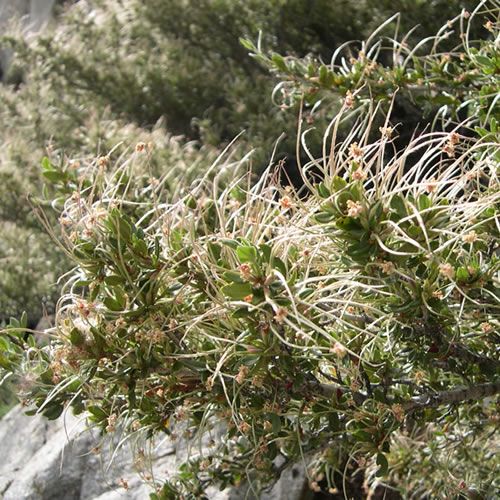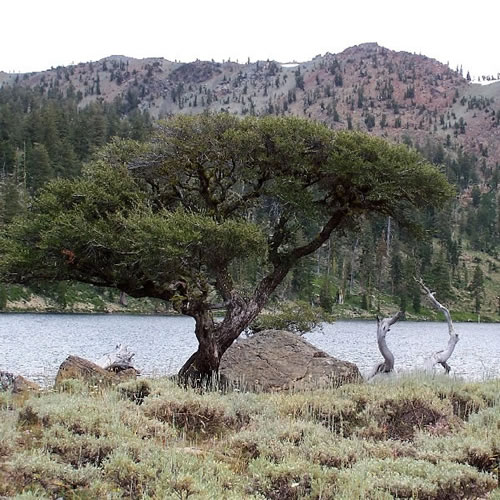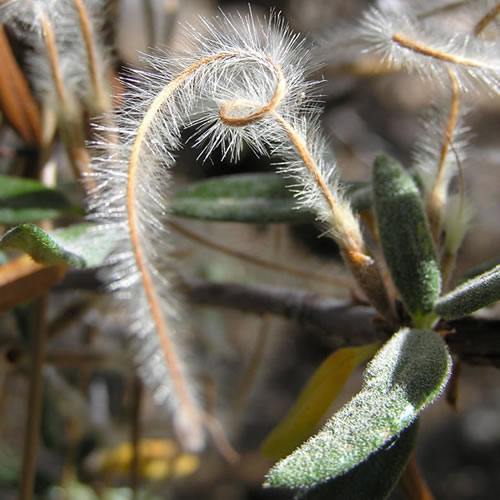Plant of the Week
 Range map of mountain mahogany. Map from USDA PLANTS Database.
Range map of mountain mahogany. Map from USDA PLANTS Database.
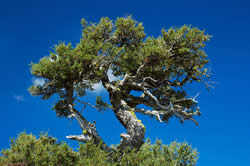 A mighty mountain mahogany. Photo by Ken DeCamp.
A mighty mountain mahogany. Photo by Ken DeCamp.
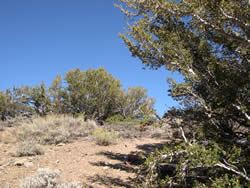 Mountain mahogany with sagebrush and rabbitbrush. Photo by Sue Weis, Botanist, Inyo National Forest.
Mountain mahogany with sagebrush and rabbitbrush. Photo by Sue Weis, Botanist, Inyo National Forest.
Mountain Mahogany (Cercocarpus ledifolius Nutt.)
By Forest Jay Gauna
Cercocarpus ledifolius, or curl-leaf Mountain Mahogany, is not a true mahogany: that distinction belongs to trees in the Meliaceae, the mahogany family. This shrubby, slow-growing tree belongs in the Rosaceae, or rose family; the common name derives from the dense, heavy wood of this tree, which sinks in water; additionally, the leaves tend to curl. The scientific name for the genus is Greek and means "tailed fruit."
A stand of these shrubby trees presents to some the appearance of a miniature African savannah. The contorted shapes of older Cercocarpus trees dominate their habitat, which is unfriendly for most other tall plants: rocky, gravelly slopes in high mountain areas, with little water and plenty sun. Typically, the plant has 1 to 4 main trunks; the trunks are not often obscured by foliage. The seeds of this plant do appear to have tails: the stigma of the flower remains attached to the seed and hardens, forming a fuzzy "tail" which facilitates wind-assisted seed dispersal. The leaves are smallish and elongated, from 1/2 to 2 inches long, and often the edges of the leaf curl inward towards the midvein. During spring, the plant flowers small, whitish-yellow flowers; the most visible part of the flowers are the stamens.
Although the wood is not suitable for lumber due to its shortness and twistedness, Native Americans (due to its strength and durability) used it for small, handmade items such as bows, spearheads, and special sticks for extricating subterranean foods. Native people also used the tree medicinally, especially the bark, in the treatment of various ills. Part of the bark is boiled with Ephedra to give the tea a pleasing taste; Cercocarpus bark tea is also used for treating colds, as well as for making a rose-coloured dye. It is good forage for browsing animals (which may partly explain the naked trunks and bushy tops) and provides winter cover for wildlife.
The hard wood is also excellent (though rare) fuel, and was used to smelt ore during the Comstock era. It is also said to be good for barbecues.


